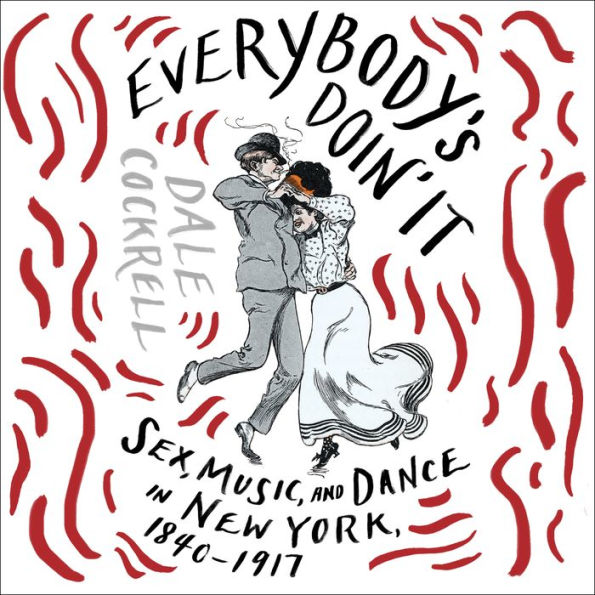Publishers Weekly
05/13/2019
In this explosive history of sex, music, and dance in New York City, Cockrell (Demons of Disorder) details an “underworld in which legions of lower-class blacks and whites danced madly to wild music-making in the search for joy and escape.” In the 1840s, the city’s dance halls and saloons were a hotbed of prostitution—and musicians fanned the flames. Outraged reformers, investigators, preachers, and politicians fought vice by implementing license requirements for liquor and entertainment, dry Sundays, and a ban on serving booze where live music was performed. But by the Civil War, commercialized sex was the city’s second-largest industry, with 400-plus musicians playing in bars and brothels. By the turn of the century, heavily syncopated ragtime was moving young New Yorkers, as Cockrell writes enthusiastically, “in fresh, sexy, uninhibited ways”; “tough dances” such as the hug-me-tight, the Bowery glide, and the turkey trot became ubiquitous. In 1913, a whopping 1,300 musicians were playing the circuit. Then came 1917, when the onset of WWI led the War Department to crack down on the so-called tenderloin districts: musicians lost gigs, and duos such as Vernon and Irene Castle performed sterilized versions of popular dances. Cockrell’s fascinating story and soundtrack of disorderly old Gotham will delight New York City historians and music buffs alike. (Aug.)
Alice Sparberg Alexiou
"Dale Cockrell takes us on a bawdy trip back to the dives and concert saloons of old New York. His book is one hell of a ride into the past, and a complicated one: he reminds us of the tragic fact that prostitution, ubiquitous at the time—after all, what options did women then have to survive?—was an integral part of New York’s rollicking music scene."
Robert Walser
"Another scintillating gem from one of the rock stars of American musicology. Cockrell draws on sources we didn’t know existed to draw conclusions we couldn’t have foreseen. He not only illuminates the music of the title’s time period but also puts jazz scholarship on a different footing. Everybody should be readin’ it!"
Susan McClary
"In this brilliant and important study, Dale Cockrell reveals the conditions within which black and white artists forged the idioms of American popular music. You’ll never listen to ragtime the same way again!"
Timothy J. Gilfoyle
"Everybody’s Doin’ It exposes the interracial and underworld origins of popular song and dance in the United States. Dale Cockrell takes us into the sensual confines of the nineteenth-century concert saloons, cabarets, dives, and dance halls propagating a new cultural genre: American popular music."
William Lhamon
"Dale Cockrell tells the stories of cellar clubs and what he calls the ‘discord of the dives.’ He scrapes the bottom of the archives to scour reports by police, tabloids, and moral reformers. Cockrell reads this neglected evidence with exuberant skepticism. Racy scholarship does the Grizzly Bear here with theoretical rigor."
Daniel Goldmark
"I devoured this book and had to keep reminding myself that Dale Cockrell couldn’t have actually been there in person! His keen archivist’s gaze has once again opened a new world for readers, showing us how much has changed and how much has stayed the same, from the backroom saloons of the 1870s to Studio 54 in the 1970s."
Kirkus Reviews
2019-05-07
A history of the hot music and provocative dancing that lit up the Gilded Age.
Cockrell (Emeritus, Musicology/Vanderbilt Univ.; Demons of Disorder: Early Blackface Minstrels and Their World, 1997) offers a colorful panorama of New York City nightlife from 1840 until the start of World War I. In the mid-19th century, music became wild: "exhilarating rhythms, a brassy sound, the thumping bass, and sinuous melodies" responded to—and incited—new dance crazes that swept the nation. Young people, and especially lower-class patrons, flocked to dance halls, a cheap and alluring form of entertainment, where they "tough danced," a term applied to energetic dances such as "the walk back, the hug-me-tight, the lovers' two-step" and sexy animal dances, such as the bunny hug, kangaroo squeeze, jackass step, and the grizzly bear. All of them gave men and women a chance to embrace, gyrate their bodies, and twirl madly. In 1909, Cockrell discovered, 95 percent of young working-class women in New York went to dance halls, some every night, most at least once a week. "Shaking of hips, shimmying, twisting, and thrusting of the lower body were all parts of the accepted repertoire of moves," writes the author. Sex was in the air: in music, dancing, and prostitution, which flourished in dance halls and saloons, inspiring determined private and public reform efforts. Drawing on newspaper reports, court records, song lyrics, reform tracts, and travel guides, among many other sources, Cockrell fashions an abundantly populated narrative featuring musical performers and composers (Irving Berlin, for one, whose hit song gives the book its title), dancers, club owners, madams, prostitutes, gangsters, reformers, preachers, policemen, politicians, and exuberant patrons of dance halls, bars, and saloons—some of which served special clienteles. "Dive," for example, was a term for a saloon frequented by blacks and whites, located in "below-sidewalk cellars"; when "dive" became applied more broadly to disreputable venues, Black-and-Tan came to refer to racially integrated establishments; and the Slide catered to gay men and women.
A well-researched and spirited cultural history.



